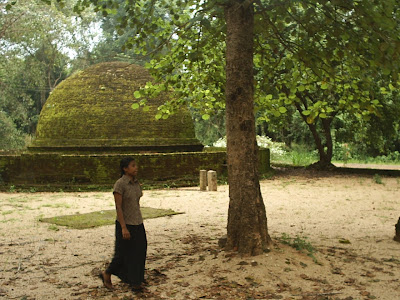Near the town of Buttala in the Moneragala district, is Yudanganawa, an ancient monastery dating back to the 2nd century BC.

Map: Yudanganawa marked in yellow
I went there in early 2005, on the way back from Tsunami relief work in Pottuvil on the East Coast. At the entrance to the complex of Yudanganawa (which means 'woman of battle' or 'beauty of battle') stands the small dagoba of Chulangani or Chulanganawa ('small woman').

Chulangani stupa
Chulanganawa was the site of a battle between King Dutugemunu (Duttha Gamini Abhaya) and his younger brother Tissa (Tisa):
And between those two there came to pass a great battle in Culanganiyapitthi: fell many thousands of the king's men. (Mahawamsa, ch. xxiv)
Tissa not only defeated his older brother, he also captured the king's war-elephant, Kandula. Dutugemunu didn't re-capture his beloved pachyderm until much later. Kandula was the most celebrated elephant in Sri Lanka's history, later being used to batter down the wrought-iron gate of a fortress:
Roaring like thunder he came, daring danger, and with his tusks pierced the panels of the gate and trampled the threshold with his feet; and with uproar the gate crashed to the ground together with the arches of the gate. (Mahawamsa, ch xxv)
As an aside it might be mentioned that, in the 21st century, Kandula's monicker was bestowed on the first male elephant to be born to the Smithsonian zoo by articifial insemination - itself the child of a first-generation Sri Lankan immigrant to the USA.
Amazingly, after his eventual victory, the king commemorated his defeat in this battle by building the Yudanganawa monastery here. It is not often that one hears of a monarch celebrating his setbacks, especially a defeat as humiliating as this one!
Close by the dagoba is the image house or buduge (literally 'Buddha House'). Only the foundation, the pillars and part of the altar remain.

Image house ('buduge') at Chulanganawa
The approach to the main dagoba at Yudanaganawa reveals its impressive size. It is not as tall as the three large dagobas at Anuradhapura, but it is much broader at the base. Unfortunately the site is heavily forested, so I found it difficult to take a good photograph of the dagoba itself.
.JPG) Yudanaganawa: main dagoba and image house
Yudanaganawa: main dagoba and image houseI first visited the image house. This is a mediaeval structure, possibly built on foundations similar to those of the Chulangani image house. Inside, it is illustrated in a typical mediaeval manner, with statues of deities and frescos and bas-reliefs on the walls.
The gateway to the inner sanctum is guarded by two painted bas-relief lions rampant. Sri Lanka has not had native lions for many centuries, and the artist was not familiar with what was almost a mythic beast. Hence, the lions looked more like large mastiffs. However they look frightening enough, so their purpose of inspiring awe in the beholder was probably served.
 Doorway to inner sanctum of image house
Doorway to inner sanctum of image houseThe inner sanctum was very dark and I could just about get photographs of the frescos and statues on my cheapish camera. The art was very mediaeval - a regression from the artistic wonders of the 1st millenium - and, in comparison with the ancient structures visible outside, was not very impressive. That may have been why they installed the two fierce looking guardian lions - to strike terror in the souls of scoffing art critics.
.JPG) Inner sanctum
Inner sanctumThe Archaeological Department has been carrying out excavation and conservation work at Yudanganawa for years, and it should continue for at least two decades more. When I went there the scaffolding, which had been erected to help with the archaeological work, was much apparent on the sides of the main dagoba.
.JPG)
Yudanganawa dagoba - note scaffolding for conservation work
The dagoba is quite different in style from conventional stupas - unlike them, it is built in two 'stages', with a smaller dagoba surmounting the massive main structure. It is rather as if the builder had sliced off the middle layer and laid the apex directly onto the base (as is apparent in the photographs below).
Noting that there was nobody around, your doughty correspondent decided to scale the scaffolding and (illicitly and with malice aforethought) climb up on top of the massive dagoba.
.JPG) The view from the top
The view from the topThe view from the top was quite impressive. It was also good to be able to see, close-up, the consevation work going on right on top of the dagoba. It was quite obvious why this work was necessary - there were trees growing on top of the structure!
.JPG) Conservation work on top
Conservation work on topIt was possible to see the hundreds of thousands of bricks of which the dagoba is composed. I wish one could say that the dagoba is made entirely of brick, but I am informed that this is not so: apparently the building contractors of yore were as shifty as their modern counterparts, and many dagobas have cores of clay.

The small stupa on top of the massive base
No comments:
Post a Comment